- Transportation and logistics companies struggle to leave behind their legacy systems and upgrade to a more flexible, scalable transportation management system (TMS).
- Companies have fragmented software solutions and need a unified network of solutions to help align the organization and meet business goals.
- The evolving marketplace makes it challenging to get a complete picture of vendors and available solutions.
Our Advice
Critical Insight
Global supply chains continue to evolve, creating complex challenges to navigate for transportation companies. To remain a competitive force within the industry, companies must find and adopt solutions that fit their use case to ensure sustainable growth and continued success.
Impact and Result
This buyers guide is intended to assist organizations in:
- Analyzing the TMS market evolutions to identify key innovations.
- Evaluating the business’ current state to understand organizational objectives and align goals with the new TMS.
- Creating criteria, shortlisting vendors, scoring options, and choosing your next solution confidently.
Equip Your Business for the Future With the Right Transportation Management System
Narrow your TMS search and find a solution that fits your needs.
Analyst perspective
Take strategic control using a TMS to ensure efficiency, agility and growth.
Transportation management systems (TMS) are critical platforms that enable transportation and logistics companies to optimize the movement of goods and their operations. In an industry that battles tight delivery windows, fluctuating costs, and high service expectations from customers, the right TMS can be the difference to having strategic control over your operations.
Transportation and logistics firms operate in fast-moving, highly competitive environments. With diverse fleets, shifting customer demands, and complex multimodal operations, companies need solutions tailored to their specific business models. A TMS can unify operations, offering visibility, automation, and decision support to enable the business to operate efficiently and grow effectively.
Transportation companies face challenges in margin pressures, rising regulatory demands, and global disruptions; a fit-for-purpose TMS can provide the foundation to assist in overcoming these challenges.
A buyers guide is essential to help organizations align their TMS selection with their business strategy. Choosing a TMS that fits your operating model, scalability needs, and data priorities ensures long-term ROI and positions the company for growth in an increasingly digital and interconnected logistics landscape.

Michael Adams
Research Analyst, Transportation and Logistics Industry
Info-Tech Research Group
Executive summary
Your Challenge
- Transportation and logistics companies struggle to leave behind their legacy systems and upgrade to more flexible, scalable transportation management systems.
- Companies have fragmented software solutions and need a unified network of solutions to help align the organization and meet business goals.
- The evolving marketplace makes it challenging to get a complete picture of vendors and navigate available solutions.
Common Obstacle
- Companies lack robust change management strategies to initiate change and ensure successful integration of new technologies.
- The fragmentation of solutions has led to data silos and incompatibility, creating difficulty in integrating and transferring necessary data.
- Stakeholder relations are getting in the way of aligning IT with the greater business goals. Different departments operate with competing priorities, making it difficult for IT leaders to gain buy-in for enterprise-wide initiatives.
Info-Tech’s Approach
- This buyers guide is intended to assist organizations in:
- Analyzing the TMS market evolutions to identify key innovations.
- Evaluating the business’ current state to understand organizational objectives and align goals with the new TMS.
- Creating criteria, shortlisting vendors, scoring options, and choosing your next solution confidently.
Info-Tech Insight
In a complex, margin-tight industry, operational efficiency is your edge. The right TMS is about orchestrating your entire business with real-time intelligence, adaptability, and control. Your TMS should be tailored to your operating model to become a performance engine for long-term resilience and growth.
Discover how a TMS impacts your organization
A transportation management system is a software solution that helps with planning and executing the physical movement of goods. It can be used to coordinate movements across different modes such as rail, ground trucking, air, and sea. A control tower is used to capture data about the goods that can then be used to plan and orchestrate the goods’ movements toward their destination.
A TMS is no longer just a logistics tool. For many transportation companies, it is the central software powering the business. By automating tasks, providing real-time visibility, and unlocking data-driven decision-making, a TMS reduces costs and enhances operational efficiency.
Some companies rely solely on a TMS as their ERP system, while others integrate the two to build a tailored tech stack that fits their needs. As global trade grows more complex, having a system that can centralize functions, navigate evolving regulations, and turn data into actionable insight is foundational to business success.
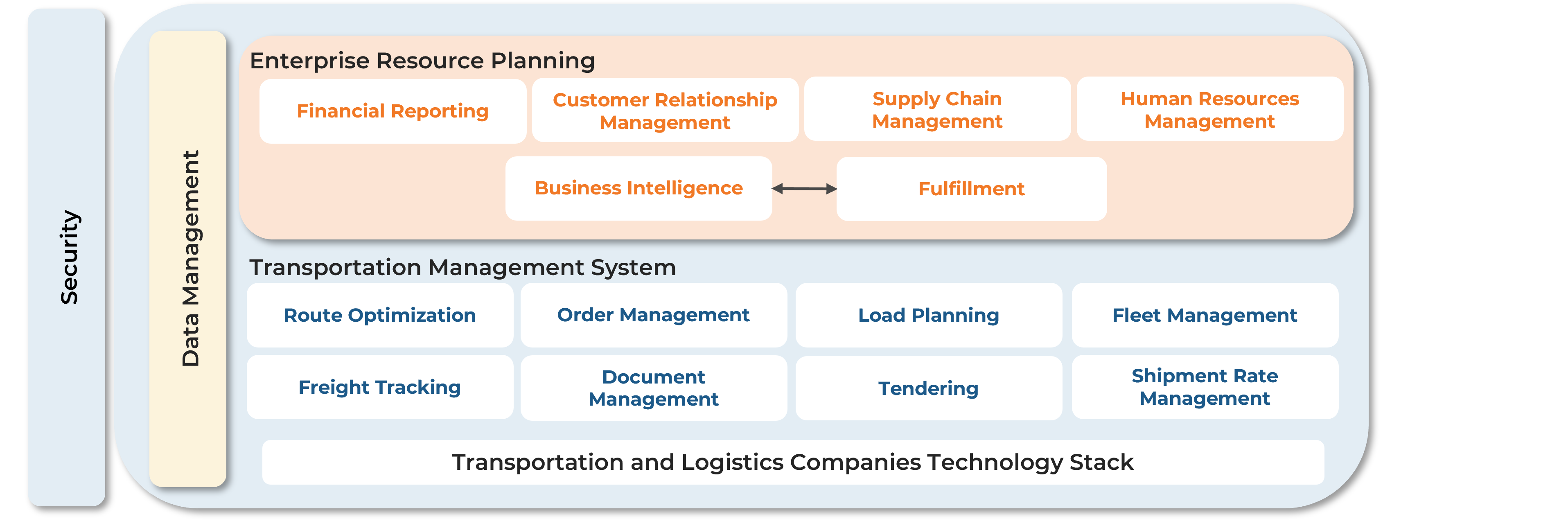
(Source: AltexSoft, 2025)
Info-Tech Insight
The physical transportation of goods is not what separates and creates revenue for transportation companies. The optimization of processes drives revenue growth, which highlights the importance of a sound TMS.
Equip your business for the future with the right TMS
Global supply chains continue to evolve, creating complex challenges for transportation companies to navigate. To remain a competitive force within the industry, companies must find and adopt solutions that fit their use case to ensure sustainable growth and continued success.
-
Identify Key Market Trends
- 1.1 Define special challenges/obstacles for the transportation and logistics industry.
- 1.2 Analyze what is happening in the evolution of the TMS market.
- 1.3 Identify gains from a TMS.
-
Define Business Requirements
- 2.1 Determine the organization’s capability map and goals.
- 2.2 Evaluate the current information state.
- 2.3 Evaluate the current level of support from the TMS.
- 2.4 Identify key features needed from the TMS.
Business capability and journey map
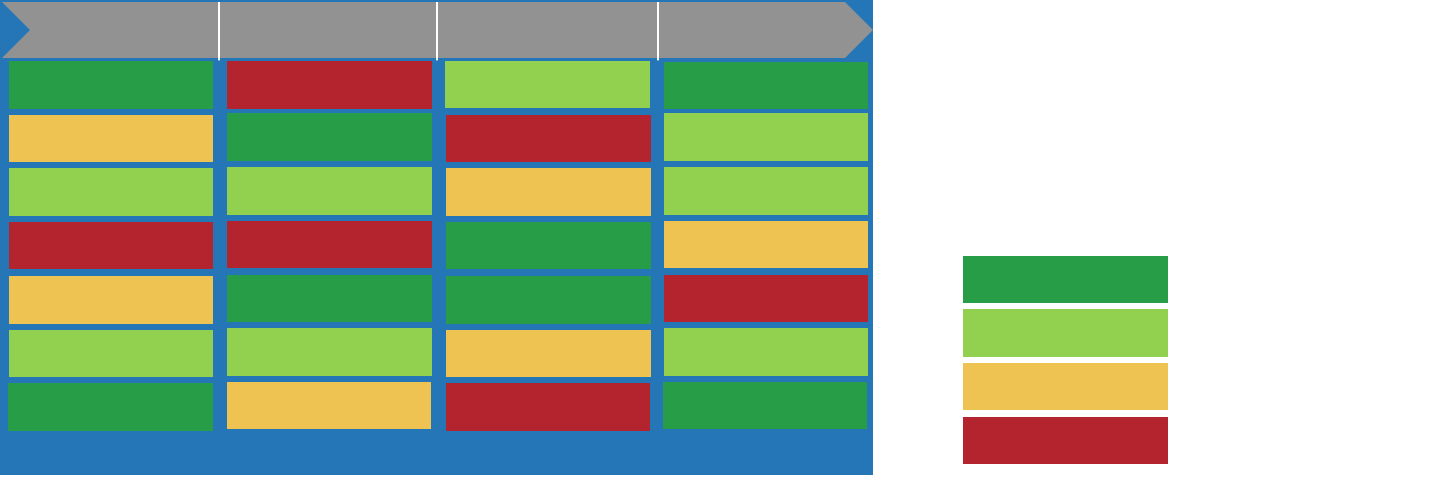
-
Assess Solutions
- 3.1 Evaluate and score TMS vendors.
- Technical Features
- Architecture
- Support
- Evaluation
- 3.1 Evaluate and score TMS vendors.
Transportation & Logistics Industry Challenges
- Legacy systems
- Demand outweighing supply
- Rising costs
- Geopolitical disruptions
TMS Evolutions
- Cloud-based solutions
- Advanced technology
- Enhanced integration capabilities
Blueprint deliverables
Key deliverable:
TMS Evaluation and Scoring Tool
Evaluate selected vendors to narrow your search and find the vendor most suitable for your company.
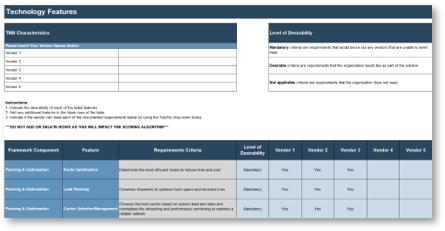
Each step of this blueprint is accompanied by supporting deliverables to help you accomplish your goals:
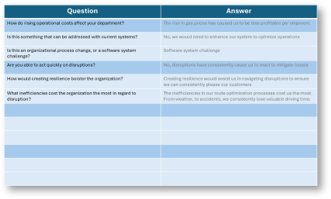
TMS Scoping Activity Workbook
Assess key challenges your company faces and how a new TMS will combat them. This workbook corresponds with the activities in Phase 1 of this storyboard.
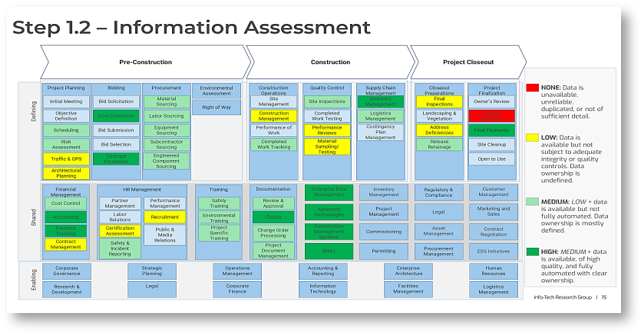
Transportation & Logistics Capability Map Workbook
Identify your company’s capability map and understand the current information assessment and level of TMS support. This workbook corresponds with and expands upon the activities in Phase 2 of this storyboard.
Guided Implementation
A Guided Implementation (GI) is a series of calls with an Info-Tech analyst to help implement our best practices in your organization.
A typical GI is 6 to 8 calls over the course of 4 to 6 months.
What does a typical GI on this topic look like?
Phase 1 |
Phase 2 |
Phase 3 |
|
| Call #1: Scope objectives for the new TMS and discuss challenges the company is facing.
Call #2: Understand the market. |
Call #3: Identify business goals and align objectives.
Call #4: Assess the current and target states of information in your organization. |
Call #5: Identify the relationship between the current state and expected gains.
Call #6: Identify key features that mend the gaps. |
Call #7: Determine evaluation criteria.
Call #8: Score and evaluate solutions. Call #9: Identify next steps. |
Workshop overview
Contact your account representative for more information.
workshops@infotech.com 1-888-670-8889
Day 1 |
Day 2 |
Day 3 |
|
Explore the Problem Space |
Evaluate the Current Business State |
Assess Vendors |
|
Activities |
1.1 Define unique challenges within the industry that are applicable to your organization. 1.2 Analyze how the TMS market has evolved over time. 1.3 Identify intended gains from a modern TMS system. |
2.1 Determine the organization’s capability map and goals. 2.2 Evaluate the organization’s current information and data assessment. 2.3 Evaluate current state and the level of TMS support. 2.4 Identify key features needed from the modern TMS. |
3.1 Evaluate and score TMS vendors. |
Deliverables |
|
|
|
Info-Tech offers various levels of support to best suit your needs
DIY Toolkit |
Guided Implementation |
Workshop |
Executive & Technical Counseling |
Consulting |
| “Our team has already made this critical project a priority, and we have the time and capability, but some guidance along the way would be helpful.” | “Our team knows that we need to fix a process, but we need assistance to determine where to focus. Some check-ins along the way would help keep us on track.” | “We need to hit the ground running and get this project kicked off immediately. Our team has the ability to take this over once we get a framework and strategy in place.” | “Our team and processes are maturing; however, to expedite the journey we'll need a seasoned practitioner to coach and validate approaches, deliverables, and opportunities.” | “Our team does not have the time or the knowledge to take this project on. We need assistance through the entirety of this project.” |
Diagnostics and consistent frameworks are used throughout all five options. |
||||
Equip Your Business for the Future With the Right Transportation Management System
Phase 1
Identify Key Market Trends
Phase 1 |
Phase 2 |
Phase 3 |
|
1.1 Identify unique industry challenges 1.2 Analyze the TMS market evolution 1.3 Identify intended gains from a modern TMS |
2.1 Analyze capability maps & organizational goals 2.2 Evaluate the current information state 2.3 Evaluate current level of support from TMS 2.4 Identify key features needed from TMS |
3.1 Evaluate and score TMS vendors |
This phase will produce the following deliverables:
- TMS Scoping Activity Workbook
- Prioritized list of trends and relevance
This phase involves the following participants:
- CIO
- COO
- Supply chain directors
- Dispatch & logistics coordinators
- Other key stakeholders as appropriate
Understand the challenges for the transportation & logistics industry
Find out how a TMS can assist in overcoming them.
-
RISING COSTS
Transportation costs continue to increase, directly attributable to rising fuel costs. Increased expenses to operate and failure to reduce transportation costs impact revenue and lead to subsequent losses for the company. -
DIGITAL OPERATIONS
Customers are beginning to demand digital operations. Legacy systems and manual processes make it difficult to keep pace with the growing demand for real-time visibility, data, and streamlined workflows. -
DEMAND OUTWEIGHING SUPPLY
The global economy relies on the transportation industry, but there is an ongoing shortage of qualified drivers and a lack of new drivers coming into the workforce. Companies must find ways to create operational efficiencies to fulfill demand if driver shortages continue. -
GEOPOLITICAL DISRUPTIONS
Supply chains present a complex web of challenges. Disruptions often have snowball effects that overwhelm the supply chain. Companies need to create agility within their operations to position themselves for success when navigating uncertainty.
(Sources: “Major Challenges,” TransPlus, 2024; Track-POD, 2023.)
Activity 1.1 Identify your most relevant industry challenges
1 hour
Input: Business strategy, General business knowledge
Output: Understanding of the industry challenges facing your organization
Materials: Whiteboard/flip charts, TMS Scoping Activity Workbook
Participants: CIO, COO, Supply chain directors, Dispatch & logistics coordinators, Other key stakeholders as appropriate
- Gather key stakeholders from relevant departments.
- Break out into department groups and discuss the key industry challenges. Facilitate open discussion, understanding each department’s challenges.
- Discuss the problem space across departments and how challenges affect the organization.
- Compile results from the breakout groups and facilitate a discussion to determine if the challenges are due to people, processes, or technology.
- How do rising operational costs affect your department?
- Is this something that could be addressed with current systems?
- Is this an organizational process challenge or a software system challenge?
- Are you able to act quickly on geopolitical disruptions?
- How would creating resilience bolster the organization?
- What inefficiencies cost the organization the most regarding disruption?
Prompt Questions:
- Use the activity workbook to log your progress with this activity.
Download the TMS Scoping Activity Workbook
Embrace the future of transportation management systems
As technology continues to evolve, so do systems like TMS. Discover the top trends driving innovation and reshaping how firms operate.
-
The acceleration of digitization for the industry:
The demand for digitization of logistics practices continues to increase, and new efficiencies are being found through modern TMS platforms.- 93% of transportation companies plan to maintain or increase their spending on digitization and technological advancements over the next three years (McKinsey, 2023).
-
The shift to cloud-based solutions:
Supply chains are dynamic and constantly changing. The industry is moving toward enabling a better cloud-connected set of solutions to meet these complexities.- Cloud-based TMS solutions account for more than 60% of the total market share (LLCBuddy, 2025).
-
The ability to integrate with other systems:
More integrations with other tools are becoming prominent, so a TMS can act as an ERP for transportation and logistics companies. Solutions are able to support and integrate data from other core functions to support data-driven decision-making processes.- 70% of organizations will integrate digital adoption platforms throughout their entire technology stack by the end of 2025 (LLCBuddy, 2025).
-
The demand for advanced technology capabilities:
As technology continues to advance, TMSs are expected to leverage innovations such as AI and IoT to enable real-time data and decision-making through advanced analytics (“What Role Will TMS Play,” Uniq TMS, 2024).- Basic usage of AI and IoT can create an instant 15% boost in productivity of delivery and supply chain performance (Redwood, 2023).
Activity 1.2 Analyze the TMS market evolution
1 hour
Input: Business strategy, General business knowledge, General TMS knowledge
Output: Justification for upgrading your current TMS platform
Materials: Whiteboard/flip charts, TMS Scoping Activity Workbook
Participants: CIO, COO, Supply chain directors, Dispatch & logistics coordinators, Other key stakeholders as appropriate
- Gather key stakeholders from relevant departments.
- Break out into groups and discuss, based on the evolution of the TMS market, where your current solution may be falling behind the industry standard, considering how the TMS supports your overall business strategy.
- Compile results from breakout groups and facilitate a discussion as to why a more modern TMS may be suitable.
- Use the activity workbook to log your progress with this activity.
Download the TMS Scoping Activity Workbook
Identify intended gains from a modern TMS
-
COST SAVINGS
Using a TMS can help businesses achieve cost savings through optimizing planning and management of freight, creating efficiencies. Companies that implement a TMS can achieve cost savings of up to 10% and improve delivery times by up to 20% (Inbound Logistics, 2025). -
ENHANCED VISIBILITY
TMS offers enhanced visibility of data. Companies can often uncover valuable data they did not know was possible, helping them address bottlenecks within their delivery process and make data-driven decisions. -
DATA CLARITY
A fully integrated TMS centralizes transportation data across modes, carriers, and regions, eliminating data silos and reducing manual entry errors. This improves data accuracy, visibility, and consistency, enabling growth and informed decision-making. -
SCALABILITY & AGILITY
As customer demands become more complex, it is increasingly important to have a scalable, agile TMS system to offer flexibility. Companies need a TMS that can support their goals to ensure growth is uninterrupted and they can take on more work (“5 Signs,” TransPlus, 2024).
Activity 1.3 Identify intended gains from a modern TMS
1 hour
Input: Business strategy, General business knowledge, General TMS knowledge
Output: Key intended gains outlined for new TMS
Materials: Whiteboard/flip charts, TMS Scoping Activity Workbook
Participants: CIO, COO, Supply chain directors, Dispatch & logistics coordinators, Other key stakeholders as appropriate
- Gather key stakeholders from relevant departments.
- Now that you have justification for why a new TMS may be needed, break out into the same groups to identify how you want the new system to impact the organization. Taking perspectives from different departments, understand what the impact looks like for each group of stakeholders.
- Compile results from the groups and prioritize the intended gains from a modern TMS to the organization. Rank each gain based on urgency and strategic fit using the following scale:
- Minimal Impact – Negligible Effect
- Low Impact – Noticeable but Minor
- Moderate Impact –Some Processes Disrupted
- High Impact – Multiple Departments Affected
- Critical Impact – Major Threat or Opportunity
- Use the activity workbook to log your progress with this activity.
Download the TMS Scoping Activity Workbook
Modernizing financial workflows for operational agility

INDUSTRY: Transportation & Logistics | SOURCE: Mastery, 2025
Werner automates financial workflows with Mastery MasterMind
Challenge
Werner Enterprises delivers truckload transportation and logistics services to customers across North America.
Werner relied heavily on manual workflows, which was straining carrier-facing teams. Legacy systems were limiting their ability to scale.
As the organization continued to grow, these manual processes became increasingly resource-intensive, and they needed to find a new solution to ensure they could scale effectively.
Solution
Werner was hoping to improve internal efficiency while enhancing the experience for its carriers. The company needed a more scalable, automated approach to reach its long-term operational goals.
Werner partnered with Mastery to automate financial processes using its configurable workflows, exception handling, and voucher processing, which was offered by its MasterMind segment. MasterMind integrated seamlessly with Werner’s established financial systems, creating efficient, scalable operations.
Results
Werner’s new solution delivered real-time payment visibility to carriers, reducing the operational burden on teams managing sensitive banking data and enhancing the carrier experience. Automated exception workflows flagged noncompliant items per load, significantly reducing manual touchpoints while maintaining strong financial controls.
Partnering with Mastery, Werner received hands-on training, effective change management, and a smooth transition. This rollout marks a critical milestone in Werner’s initiative to modernize its solutions and drive long-term efficiency.
Equip Your Business for the Future With the Right Transportation Management System
Phase 2
Define Business Requirements
Phase 1 | Phase 2 | Phase 3 |
1.1 Identify unique industry challenges 1.2 Analyze the TMS market evolution 1.3 Identify intended gains from a modern TMS | 2.1 Analyze capability maps & organizational goals 2.2 Evaluate the current information state 2.3 Evaluate current level of support from TMS 2.4 Identify key features needed from TMS | 3.1 Evaluate and score TMS vendors |
This phase will produce the following deliverables:
- Business capability map
- Current-state information assessment
- Current-state TMS support assessment
- Key features list
This phase involves the following participants:
- CIO
- COO
- Supply chain directors
- Dispatch & logistics coordinators
- Other key stakeholders as appropriate
Analyze business goals and objectives
Identifying business goals is the first step in aligning your team with the business vision for making a technological transformation.
- IT leaders must understand the direction the business is taking.
- Investments in technology should align with the business’ short- and long-term objectives to ensure strategic value.
- Buy-in for IT investments is best created when stakeholders can envision the alignment with business priorities.
- A TMS should support operations by addressing logistical pain points and enhancing performance across the entire value chain.
In all, businesses need to leverage IT strategically and position it as a value generator rather than a cost center.
Key Tactics to Identify Organizational Goals
- Review an existing business strategy. If you cannot identify corporate goals, use business goals instead.
- Ask questions to identify relevant objectives:
- What message is being delivered by the CEO?
- What are the main themes of investments and projects?
- What are the senior leaders measured on?
55% of CxOs believe there is too much focus on short-term ROI instead of long-term value measures when understanding IT investments (Deloitte Insights, 2023).
69% of technology leaders understand they need to get better at helping the board understand the potential gains from new technologies (KPMG, 2023).
2.1 Develop capability maps and organizational goals
Transportation & Logistics Business Capability Map
In business architecture, the core view of an organization is the business capability map, which includes both business capabilities and value chains.
A business capability describes what the organization does to create value, not how it does it.
A value chain offers a high-level view of how the industry delivers value to the customer across an end-to-end process.
The business capability map helps practitioners focus on specific areas of the organization for deeper analysis and improvement.

Note: This capability map is an example that can be customized to a specific organization.
Download the Transportation & Logistics Business Reference Architecture Guide
Download the Transportation & Logistics Business Reference Architecture Template
